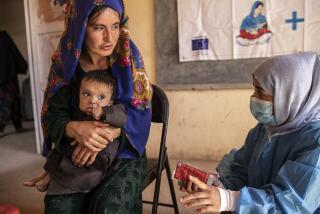Afghans Feel the Bite of a Pest the War Nourished
- Share via
KABUL, Afghanistan — Phlebotomus sergenti is a tiny gray sand fly slightly smaller than a mosquito. It feeds on human blood and, when feasting, can transmit parasites called leishmania.
One fly bit Mansoor Mimtaza the day he was born. That was 10 months ago, and he still has a weepy red lesion beside his tiny pug nose.
A sand fly also bit Mohammed Sarwar, 52, leaving a crusty purple scab along his terribly swollen right wrist.
Hundreds of victims--old, young and newborn--arrive daily at the Khair Khana Clinic here in the Afghan capital to be treated for an affliction that isn’t fatal but is painful, traumatic and disfiguring. Cutaneous leishmaniasis, the lesion caused by the bite of an infected sand fly, is reaching epidemic proportions in Kabul and other Afghan cities.
Inside the clinic, children wriggle and howl as clinicians probe their lesions and inject the sores with medication. Older boys and men clench their teeth or bellow in pain while a ragged line of blistered mothers and fathers, children and grandparents snakes through the mud outside.
The war and destruction of last fall helped create fertile breeding grounds for the sand fly, which proliferates in damp areas and among debris, garbage and sewage. Health Net International, a Dutch humanitarian aid group that funds the Khair Khana Clinic, estimates that 69,000 new cases of leishmaniasis will break out in Kabul alone this summer.
“Once you have an infected population, the parasite easily travels from one person to the next as flies bite infected people and then bite someone else,” said Esmee de Jong, a Health Net International coordinator.
The grimy faces of many children begging on the streets of Afghan cities bear deep scars and pockmarks from the disease. People with the scars, whether young or old, are often shunned or stigmatized in Afghan society.
A survey by Health Net International found that most young women with scars from sand fly lesions cannot attract a husband and are ostracized by their families. Many mothers refuse to let their scarred offspring eat with the rest of the family.
“There is a terrible stigma, a real social rejection,” said Kamal Mustafa, a microbiologist with the World Health Organization in Kabul.
To Afghans, leishmaniasis is known as soldana--the “sore for a year”--because the lesions fester for up to 12 months before they heal and harden into scars. The disease is common in the Middle East and Central Asia.
It is so prevalent that the Khair Khana Clinic resorts to a brutal form of triage. Of the several hundred new patients who arrive on a typical treatment day, the clinic usually can treat only 30, 15 males and 15 females. Without treatment, victims recover within a year as their bodies develop antibodies, and they are immune for life.
The clinic staff selects only the most severely infected patients. Infected joints such as a knee or elbow can become immobile if not treated.
The clinic and its 10-member staff treated 96 patients when it opened in 1997. It treated 4,490 last year and 1,708 in the first three months of this year, which points to about 7,000 cases for 2002.
Patients receive painful injections of sodium stibogluconate, a drug that costs $130 a dose in Britain but is provided to the clinic by WHO for $12 a dose through an Indian pharmaceutical company, De Jong said.
Working recently in a sunny room was Abdul Qayemudin, a sturdy, bearded man in a white lab coat. A container of disposable syringes lay at his elbow.
Qayemudin worked quickly and efficiently, a one-man production line. He smiled tenderly at children and tried to cajole them. He politely asked men and older boys to either drop their pantaloons or present their lesions. The drug was injected into a patient’s buttock or directly into a lesion.
Fathers and mothers and older siblings dragged in terrified children, who saw the needles and began to wail. About 53% of the clinic’s patients are 14 or younger. An assistant was on hand to help subdue recalcitrant men. Girls and women were treated in a separate room.
Once inoculated, the men pulled up their pantaloons and shuffled out. The children bolted for the door. Each time, Qayemudin silently unwrapped and filled a fresh syringe.
Outside, a long procession of people with sore, splotched faces stood in silence, listening to the sharp wails of the children inside, waiting and praying for something to make their pain and their lesions disappear.
More to Read
Sign up for Essential California
The most important California stories and recommendations in your inbox every morning.
You may occasionally receive promotional content from the Los Angeles Times.














